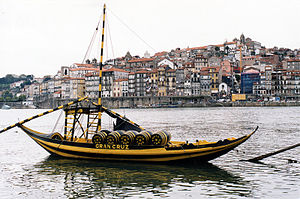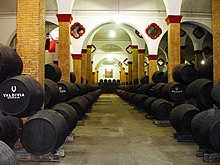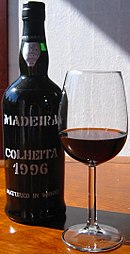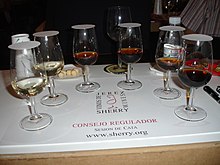You are using an out of date browser. It may not display this or other websites correctly.
You should upgrade or use an alternative browser.
You should upgrade or use an alternative browser.
Thinking outside the box
- Thread starter joeswine
- Start date

Help Support Winemaking Talk - Winemaking Forum:
This site may earn a commission from merchant affiliate
links, including eBay, Amazon, and others.
joeswine
joeswine
- Joined
- Nov 15, 2007
- Messages
- 8,695
- Reaction score
- 2,702
The port
Portuguese wine


The traditional rabelo boat, used to transport Port Wine from the Douro Valley to the cellars near the city of Porto.
Portuguese wine is the result of traditions introduced to the region by ancient civilizations, such as the Phoenicians, Carthaginians, Greeks, and mostly the Romans. Portugal started to export its wines to Rome during the Roman Empire. Modern exports developed with trade to England after the Methuen Treaty in 1703. From this commerce a wide variety of wines started to be grown in Portugal. And, in 1758, one of the first wine-producing region of the world, the Região Demarcada do Douro was created under the orientation of Marquis of Pombal, in the Douro Valley. Portugal has two wine producing regions protected by UNESCO as World Heritage: the Douro Valley Wine Region (Douro Vinhateiro) and Pico Island Wine Region (Ilha do Pico Vinhateira). Portugal has a large variety of native breeds, producing a very wide variety of different wines with distinctive personality.
Portuguese wine


The traditional rabelo boat, used to transport Port Wine from the Douro Valley to the cellars near the city of Porto.
Portuguese wine is the result of traditions introduced to the region by ancient civilizations, such as the Phoenicians, Carthaginians, Greeks, and mostly the Romans. Portugal started to export its wines to Rome during the Roman Empire. Modern exports developed with trade to England after the Methuen Treaty in 1703. From this commerce a wide variety of wines started to be grown in Portugal. And, in 1758, one of the first wine-producing region of the world, the Região Demarcada do Douro was created under the orientation of Marquis of Pombal, in the Douro Valley. Portugal has two wine producing regions protected by UNESCO as World Heritage: the Douro Valley Wine Region (Douro Vinhateiro) and Pico Island Wine Region (Ilha do Pico Vinhateira). Portugal has a large variety of native breeds, producing a very wide variety of different wines with distinctive personality.
joeswine
joeswine
- Joined
- Nov 15, 2007
- Messages
- 8,695
- Reaction score
- 2,702
Continued
Production [


Sherry barrels aging.
The original reason for fortifying wine was to preserve it, since ethanol is a natural antiseptic. Even though other preservation methods now exist, fortification continues to be used because the process can add distinct flavors to the finished product.[citation needed]
Although grape brandy is most commonly added to produce fortified wines, the additional alcohol may also be neutral spirit that has been distilled from grapes, grain, sugar beets, or sugarcane. Regional appellation laws may dictate the types of spirit that are permitted for fortification.
The source of the additional alcohol and the method of its distillation can affect the flavor of the fortified wine. If neutral spirit is used, it will usually have been produced with a continuous still, rather than a pot still.[2]
When added to wine before the fermentation process is complete, the alcohol in the distilled beverage kills the yeast and leaves residual sugar behind. The end result is a wine that is both sweeter and stronger, normally containing about 20% alcohol by volume (ABV).
During the fermentation process, yeast cells in the must continue to convert sugar into alcohol until the must reaches an alcohol level of 16%–18%. At this level, the alcohol becomes toxic to the yeast and kills it. If fermentation is allowed to run to completion, the resulting wine will (in most cases) be low in sugar and will be considered a dry wine. The earlier in the fermentation process that alcohol is added, the sweeter the resulting wine will be. For drier fortified wine styles, such as sherry, the alcohol is added shortly before or after the end of the fermentation.
In the case of some fortified wine styles (such as late harvest and botrytized wines), a naturally high level of sugar will inhibit the yeast. This causes fermentation to stop before the wine can become dry.[2]
Mistelle [
Mistelle (Italian: mistella; French: mistelle; Spanish, Portuguese, Galician and Catalan: mistela, from Latin mixtella/mixtvm "mix") is sometimes used as an ingredient in fortified wines, particularly Vermouth, Marsala and Sherry, though it is used mainly as a base for apéritifs such as the French Pineau des Charentes.[3] It is produced by adding alcohol to non-fermented or partially fermented grape juice.[4] The addition of alcohol stops the fermentation and, as a consequence Mistelle is sweeter than fully fermented grape juice in which the sugars turn to alcohol.[5]
Varieties [


Madeira wine
Madeira wineMain article: Madeira wine
Madeira is a fortified wine made in the Madeira Islands. The wine is produced in a variety of styles ranging from dry wines which can be consumed on their own as an aperitif, to sweet wines more usually consumed with dessert.
Marsala wine [
Main article: Marsala wine
Marsala wine is a wine from Sicily that is available in both fortified and unfortified versions.[6] It was first produced in 1772 by an English merchant, John Woodhouse, as an inexpensive substitute for sherry and port,[7] and gets its name from the island's port, Marsala.[6] The fortified version is blended with brandy to make two styles, the younger, slightly weaker Fine, which is at least 17% abv and aged at least four months; and the Superiore, which is at least 18%, and aged at least two years. The unfortified Marsala wine is aged in wooden casks for five years or more and reaches a strength of 18% by evaporation.[6]
Port wine [
Main article: Port wine
Port wine (also known simply as Port) is a fortified wine from the Douro Valley in the northern provinces of Portugal.[8] It is typically a sweet red wine, but also comes in dry, semi-dry and white varieties.
Sherry [


A degustation of sherries
Production [


Sherry barrels aging.
The original reason for fortifying wine was to preserve it, since ethanol is a natural antiseptic. Even though other preservation methods now exist, fortification continues to be used because the process can add distinct flavors to the finished product.[citation needed]
Although grape brandy is most commonly added to produce fortified wines, the additional alcohol may also be neutral spirit that has been distilled from grapes, grain, sugar beets, or sugarcane. Regional appellation laws may dictate the types of spirit that are permitted for fortification.
The source of the additional alcohol and the method of its distillation can affect the flavor of the fortified wine. If neutral spirit is used, it will usually have been produced with a continuous still, rather than a pot still.[2]
When added to wine before the fermentation process is complete, the alcohol in the distilled beverage kills the yeast and leaves residual sugar behind. The end result is a wine that is both sweeter and stronger, normally containing about 20% alcohol by volume (ABV).
During the fermentation process, yeast cells in the must continue to convert sugar into alcohol until the must reaches an alcohol level of 16%–18%. At this level, the alcohol becomes toxic to the yeast and kills it. If fermentation is allowed to run to completion, the resulting wine will (in most cases) be low in sugar and will be considered a dry wine. The earlier in the fermentation process that alcohol is added, the sweeter the resulting wine will be. For drier fortified wine styles, such as sherry, the alcohol is added shortly before or after the end of the fermentation.
In the case of some fortified wine styles (such as late harvest and botrytized wines), a naturally high level of sugar will inhibit the yeast. This causes fermentation to stop before the wine can become dry.[2]
Mistelle [
Mistelle (Italian: mistella; French: mistelle; Spanish, Portuguese, Galician and Catalan: mistela, from Latin mixtella/mixtvm "mix") is sometimes used as an ingredient in fortified wines, particularly Vermouth, Marsala and Sherry, though it is used mainly as a base for apéritifs such as the French Pineau des Charentes.[3] It is produced by adding alcohol to non-fermented or partially fermented grape juice.[4] The addition of alcohol stops the fermentation and, as a consequence Mistelle is sweeter than fully fermented grape juice in which the sugars turn to alcohol.[5]
Varieties [


Madeira wine
Madeira wineMain article: Madeira wine
Madeira is a fortified wine made in the Madeira Islands. The wine is produced in a variety of styles ranging from dry wines which can be consumed on their own as an aperitif, to sweet wines more usually consumed with dessert.
Marsala wine [
Main article: Marsala wine
Marsala wine is a wine from Sicily that is available in both fortified and unfortified versions.[6] It was first produced in 1772 by an English merchant, John Woodhouse, as an inexpensive substitute for sherry and port,[7] and gets its name from the island's port, Marsala.[6] The fortified version is blended with brandy to make two styles, the younger, slightly weaker Fine, which is at least 17% abv and aged at least four months; and the Superiore, which is at least 18%, and aged at least two years. The unfortified Marsala wine is aged in wooden casks for five years or more and reaches a strength of 18% by evaporation.[6]
Port wine [
Main article: Port wine
Port wine (also known simply as Port) is a fortified wine from the Douro Valley in the northern provinces of Portugal.[8] It is typically a sweet red wine, but also comes in dry, semi-dry and white varieties.
Sherry [


A degustation of sherries
RCGoodin
Senior Member
Joe,
Thank you for s great history lesson. Happy 4th also.
Thank you for s great history lesson. Happy 4th also.
joeswine
joeswine
- Joined
- Nov 15, 2007
- Messages
- 8,695
- Reaction score
- 2,702
Vineland NJ Amateur Wine Competition Aug 10, 2013
Vineland NJ is holding their annual Amateur Wine Competition to be held in the city of Vineland, NJ.
It's free to enter, just send in 3 bottles.
I am attaching the form for everyone to download.
Instructions are on the form.
I wont be entering as I will be helping orchestrate it, so now all of you have a chance to win!!


Cheers!
Joeswine
View attachment 2013 wine competition entry form.pdf
Vineland NJ is holding their annual Amateur Wine Competition to be held in the city of Vineland, NJ.
It's free to enter, just send in 3 bottles.
I am attaching the form for everyone to download.
Instructions are on the form.
I wont be entering as I will be helping orchestrate it, so now all of you have a chance to win!!


Cheers!
Joeswine
View attachment 2013 wine competition entry form.pdf
RCGoodin
Senior Member
Joe, You'd be proud of me. I opened a bottle of my Orange Almond Chardonnay last night. It was great. It's about a 1 1/2 years old now and has a great finish. I taste the almond a lot more than the orange, but that is the way we created it.
Ok, Happy Wining to all.............
Ok, Happy Wining to all.............
joeswine
joeswine
- Joined
- Nov 15, 2007
- Messages
- 8,695
- Reaction score
- 2,702
almond wine








I HAVE FINIAL BOTTLED MY ALMOND WINE AND IT IS GREAT, I'll LET YOU KNOW IF I PLACE WITH IT IN THE UP COMING CONTEST OR NOT.
THIS IS A GREAT BALANCE BETWEEN FRUIT AND WINE OR IN THIS CASE ALMOND AND FRUIT FROWARD CHARDENAY...WHEN YOUR READY S=WE CAN SWAP 375 BOTTLES FOR TASTING . GLAD YOU CHOICE TO THINK OUTSIDE THE BOX.
GLAD YOU CHOICE TO THINK OUTSIDE THE BOX.








I HAVE FINIAL BOTTLED MY ALMOND WINE AND IT IS GREAT, I'll LET YOU KNOW IF I PLACE WITH IT IN THE UP COMING CONTEST OR NOT.
THIS IS A GREAT BALANCE BETWEEN FRUIT AND WINE OR IN THIS CASE ALMOND AND FRUIT FROWARD CHARDENAY...WHEN YOUR READY S=WE CAN SWAP 375 BOTTLES FOR TASTING .
 GLAD YOU CHOICE TO THINK OUTSIDE THE BOX.
GLAD YOU CHOICE TO THINK OUTSIDE THE BOX.
joeswine
joeswine
- Joined
- Nov 15, 2007
- Messages
- 8,695
- Reaction score
- 2,702
fun with extracts
 sammyk and rc goodin have applied the extracts method and have had a great experience with them have you tried to apply yet? using simple syrup and a base you can create a taste of your own....review the process ,ask questions, have FUN WITH WINE AND EXTRACTS.
sammyk and rc goodin have applied the extracts method and have had a great experience with them have you tried to apply yet? using simple syrup and a base you can create a taste of your own....review the process ,ask questions, have FUN WITH WINE AND EXTRACTS.
Citrus Extract:Consists of The zest of 2 limes, the zest of 2 lemons, and the zest of 2grapefruits, and the remainder is ever Kleer.
Coffee Extract ill Ball jar up with roasted coffee beans (your choice), fill the balance ofthe Ball jar with Ever Kleer.
ill Ball jar up with roasted coffee beans (your choice), fill the balance ofthe Ball jar with Ever Kleer.
Cinnemon Extract-~approx. 12 sticks per Ball jar, top up with Ever Kleer
Lemon extract- The Zest of 12 lemons per jar, top up withEver Kleer
Orange extract: Thezest of approx.. 8 oranges per jar. Valenzia oranges work best but any typewill do.
Key Lime Extract:1 bag of key limes with the limes cut in half.
Vanilla Extract:6 Madagascar Vanilla Beans, sliced length wise. Put all 6 in a ball jar and topoff with Ever Kleer.
At the end of one full year its best to pour the extractthrough some sort of filter (I strain mine through a coffee filter) and addsome additional zest of the same type back to it and top it off with EverKleer.
Basic mix consists of : 2 qt. ball jars of cane sugar to 1qt. ball jar of water.
Process:
Place measured out sugar into a metal pot. Add the water tothe mix (It’s a 2 to 1 ratio-mix). Bring the mixture to a boil, constantlystirring from the beginning of the process to the end until the liquid is clear.Have the ball jars already sanitized and ready for filling. Bring the simplesyrup TO the jar and and funnel it into them (make sure your funnel is clean,too!) to fill them up. It will be hot so be very careful. Place the lids andmetal rings onto the jars to seal them.
Note: we put the very hot liquid into the jarswhile it is hot so as it cools it creates a vacuum seal to keep the mixturegood. Done this way, your simple syrup will have a very long shelf life.
Zesting is the process of the removal of the color of mostcitrus fruits and other entities that are oil extracted (for their essence). Weuse a micro plane zester to accomplish our end. See pictures. (If you do not have a micro plane zester you can use afine cheese grater (Your goal is to get the color off the fruit, not the pitch,which is the “white stuff” underneath the very top layer of the fruit.)










 sammyk and rc goodin have applied the extracts method and have had a great experience with them have you tried to apply yet? using simple syrup and a base you can create a taste of your own....review the process ,ask questions, have FUN WITH WINE AND EXTRACTS.
sammyk and rc goodin have applied the extracts method and have had a great experience with them have you tried to apply yet? using simple syrup and a base you can create a taste of your own....review the process ,ask questions, have FUN WITH WINE AND EXTRACTS.
All recipes aremeasured out with one quart Ball Jar.
Citrus Extract:Consists of The zest of 2 limes, the zest of 2 lemons, and the zest of 2grapefruits, and the remainder is ever Kleer.
Coffee Extract
 ill Ball jar up with roasted coffee beans (your choice), fill the balance ofthe Ball jar with Ever Kleer.
ill Ball jar up with roasted coffee beans (your choice), fill the balance ofthe Ball jar with Ever Kleer. Cinnemon Extract-~approx. 12 sticks per Ball jar, top up with Ever Kleer
Lemon extract- The Zest of 12 lemons per jar, top up withEver Kleer
Orange extract: Thezest of approx.. 8 oranges per jar. Valenzia oranges work best but any typewill do.
Key Lime Extract:1 bag of key limes with the limes cut in half.
Vanilla Extract:6 Madagascar Vanilla Beans, sliced length wise. Put all 6 in a ball jar and topoff with Ever Kleer.
At the end of one full year its best to pour the extractthrough some sort of filter (I strain mine through a coffee filter) and addsome additional zest of the same type back to it and top it off with EverKleer.
Making Simple Syrup
Basic mix consists of : 2 qt. ball jars of cane sugar to 1qt. ball jar of water.
Process:
Place measured out sugar into a metal pot. Add the water tothe mix (It’s a 2 to 1 ratio-mix). Bring the mixture to a boil, constantlystirring from the beginning of the process to the end until the liquid is clear.Have the ball jars already sanitized and ready for filling. Bring the simplesyrup TO the jar and and funnel it into them (make sure your funnel is clean,too!) to fill them up. It will be hot so be very careful. Place the lids andmetal rings onto the jars to seal them.
Note: we put the very hot liquid into the jarswhile it is hot so as it cools it creates a vacuum seal to keep the mixturegood. Done this way, your simple syrup will have a very long shelf life.
Zesting Made Simple
Zesting is the process of the removal of the color of mostcitrus fruits and other entities that are oil extracted (for their essence). Weuse a micro plane zester to accomplish our end. See pictures. (If you do not have a micro plane zester you can use afine cheese grater (Your goal is to get the color off the fruit, not the pitch,which is the “white stuff” underneath the very top layer of the fruit.)










Last edited:
Stressbaby
Just a Member
- Joined
- Aug 19, 2012
- Messages
- 2,080
- Reaction score
- 840
Joe,
There may be another way of making extracts which may work for foods like nuts or coconut with a lot of fat. That method is gelatin filtering. It sounds like it uses a combination of gelatin fining and freeze distillation to arrive at a clear, water-based extract.
I intend to try this with coconut and add it to a gallon of my lemongrass wine. I will post results.
http://www.nytimes.com/2007/09/05/dining/05curi.html
http://www.molecularrecipes.com/techniques/gelatin-filtered-consomme-gelatin-filtration/
http://www.eatfoo.com/archives/2008/02/gelatin_filtration.php
There may be another way of making extracts which may work for foods like nuts or coconut with a lot of fat. That method is gelatin filtering. It sounds like it uses a combination of gelatin fining and freeze distillation to arrive at a clear, water-based extract.
I intend to try this with coconut and add it to a gallon of my lemongrass wine. I will post results.
http://www.nytimes.com/2007/09/05/dining/05curi.html
http://www.molecularrecipes.com/techniques/gelatin-filtered-consomme-gelatin-filtration/
http://www.eatfoo.com/archives/2008/02/gelatin_filtration.php
the_rayway
Always busy
- Joined
- Aug 3, 2012
- Messages
- 1,760
- Reaction score
- 931
For citrus fruits, I actually use my potato peeler - it takes off the exact right amount of zest - no pith - and it's in nice large pieces 
joeswine
joeswine
- Joined
- Nov 15, 2007
- Messages
- 8,695
- Reaction score
- 2,702
almond wine
finally a almond wine that could take a second place at 2 years old, but where going to take this one even higher, just watch.
actually the base is a Californian fruit forward Chardonnay perfectly match wine with an aroma fill almond extract and what a taste.this is and will be a desert wine winner ...

finally a almond wine that could take a second place at 2 years old, but where going to take this one even higher, just watch.

actually the base is a Californian fruit forward Chardonnay perfectly match wine with an aroma fill almond extract and what a taste.this is and will be a desert wine winner ...

LoneStarLori
Veteran wino, newbie vintner
- Joined
- Aug 6, 2013
- Messages
- 1,311
- Reaction score
- 565
This is a project inspired from Joeswine Sangiovese. I had just started a WE Mezza Luna white kit the day before I saw his thread so it was a great time to try adding some white raisins. Since I can never leave well enough alone, I decided to add some Plumeria flowers that I had growing in my yard. They are not a real strong scent and I think they will add just a little to the bouquet. I'm going to try and post some pics of the progress.
I let it run it's course int he primary bucket according to directions on the kit. Starting with a 1.10 and ending with a 1.01 SG. Then added the raisins, tannin and flowers when I transferred it to the 2ndary. I was so excited to get it going, I forgot to add the raisins prior to transferring it to the carboy, so I had to put it back in the primary and start over. (duh) On day 2 I have bubble action!
This is my first kit wine and I probably should have done it as directed. But it tasted a little light to me so I wanted to try and a little something.








I let it run it's course int he primary bucket according to directions on the kit. Starting with a 1.10 and ending with a 1.01 SG. Then added the raisins, tannin and flowers when I transferred it to the 2ndary. I was so excited to get it going, I forgot to add the raisins prior to transferring it to the carboy, so I had to put it back in the primary and start over. (duh) On day 2 I have bubble action!
This is my first kit wine and I probably should have done it as directed. But it tasted a little light to me so I wanted to try and a little something.








Similar threads
- Replies
- 6
- Views
- 479
- Replies
- 6
- Views
- 484




 DID YOU READ ABOUT THE SHERRIES AND PORT STYLES?
DID YOU READ ABOUT THE SHERRIES AND PORT STYLES?























